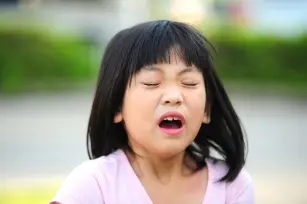
If your child is sneezing despite not having a runny nose, or suffering from unexplained rashes that suddenly pop up, be vigilant – it could be an allergy. There are a lot of allergens in the air and food that can sensitize a child. If you think this is possible, contact your pediatrician. When your concerns are justified, your doctor will refer you to an allergist specialist.
- Mites – this type of allergy affects children aged 1 to 2 years, but also older children. It can last a lifetime or disappear with the onset of puberty. Mites are arachnids that cannot be seen with the naked eye. They are everywhere, especially in places where dust collects. Allergies worsen in the fall. Its typical symptoms are shortness of breath, runny nose, cough, atopic dermatitis.
- Pollen both grasses and trees. This applies primarily to children over 4 years of age. The highest concentration of this allergen occurs, of course, in summer and spring, although symptoms may appear as early as January, when hazel pollination begins. The most common symptoms are coughing, sneezing, shortness of breath, runny nose.
- Mold spores – This type also affects children over 4 years of age. Most often, the symptoms persist throughout life, although it happens that they subside. The spores are spread by mold fungi that thrive in damp places and potting soil. Symptoms, which are intensified mainly in autumn and during humid summer, include conjunctivitis, rash, runny nose, scratchy throat, shortness of breath, and paroxysmal cough.
- Eggs, milk, gluten – symptoms occur either immediately after their introduction to the diet, or a few months after. Usually, the first signs appear in babies, but almost 90% of babies grow out of this allergy after 2-3 years of age. The most common symptoms are colic, diarrhoea, rash and vomiting (or frequent regurgitation). The treatment consists in introducing an elimination diet, i.e. removing allergens from the child’s menu.
- Chemistry and some cosmetics – this type of allergy can affect everyone – infants, children, adults. It is possible that the symptoms are milder. The youngest children are most often allergic to laundry detergents, but often the problem also concerns bath liquids, soaps, creams. Symptoms include burning and itching of the skin, tearing, irritation or sores under the influence of the allergen, the appearance of a rash.
- Animal dander – Guinea pig and cat hair, as well as their epidermis and saliva, are the most allergenic. Despite this, the cause of allergies can also be rabbits, dogs, hamsters. This type of allergy does not grow out of, and affects children after the age of four. The symptoms of allergy to hair are shortness of breath, sometimes a rash, cough, runny nose, tearing.









